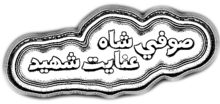Shah Inayatullah | |
|---|---|
شاه عنایت اللہ | |
 Written name of Shah Inayat in Sindhi | |
| Title | Hazrat Sultan ul-Arifeen Shah Shaheed |
| Personal | |
| Born | c.1655 (AH 1665) |
| Died | 7 January 1718 (Safar 17,1130 AH) |
| Religion | Islam |
| Era | Medieval |
| Region | Sindh, Mughal Empire |
| Creed | Sufism |
| Known for | Sufi poetry, Social reforms |
| Organization | |
| Order | Sufi al-Qadiri[1][2] |
| Muslim leader | |
| Teacher | Shah Abdul Malik of Bijapur[3][4][5] |
Influenced | |
| Initiation | into Sufi al-Qadiri Tariqah by Shah Abdul Malik of Bijapur[6][7][8] |
Shah Inayatullah (Sindhi: شاه عنایت اللہ; c. 1655 – 1718),[9] popularly known as Sufi Shah Inayat Shaheed, Shah Shaheed or Shah Inayat of Jhok, was a 17th-century Sindhi Sufi saint and revolutionary from Jhok.[10][11] He was the first socialist and agricultural reformist of Sindh.[12]
He was executed on the order of Mughal Emperor Farrukhsiyar in the early eighteenth century. Sufi Inayat was accused of leading a small army of peasants (Harees) to challenge the domination of Farrukhsiyar, local feudal landlords, and Mullahs. His mantra, “Jo Kherray so Khaey” (Sindhi: جو کيڙي سو کائي), means, "The one who plows has the foremost right on the yield." His popularity forced the feudal landlords to contact Farrukhsiyar, who ordered the ruler of northern Sindh Mian Yar Muhammad Kalhoro to uproot Inayat and his companions. A prolonged siege of Jhok resulted in an offer of negotiations from the Kalhora commander. Sufi Inayat accepted the offer to avoid further bloodshed, but was instead arrested and later executed in Thatto.,[10]
- ^ Sarah Ansari. Sufi Saints And State Power - The Pirs of Sind (1843-1947) (PDF). Cambridge University Press.
- ^ Bennett, Clinton; Ramsey, Charles M. (1 March 2012). South Asian Sufis: Devotion, Deviation, and Destiny. A&C Black. ISBN 978-1-4411-5127-8.
- ^ Sarah Ansari. Sufi Saints And State Power - The Pirs of Sind (1843-1947) (PDF). Cambridge University Press.
- ^ Bennett, Clinton; Ramsey, Charles M. (1 March 2012). South Asian Sufis: Devotion, Deviation, and Destiny. A&C Black. ISBN 978-1-4411-5127-8.
- ^ Bahr-ul-Ameeq: Kalam Hazrat Syed Cheezal Shah Sufi Ul Qadri.
- ^ Sarah Ansari. Sufi Saints And State Power - The Pirs of Sind (1843-1947) (PDF). Cambridge University Press.
- ^ Bennett, Clinton; Ramsey, Charles M. (1 March 2012). South Asian Sufis: Devotion, Deviation, and Destiny. A&C Black. ISBN 978-1-4411-5127-8.
- ^ Bahr-ul-Ameeq: Kalam Hazrat Syed Cheezal Shah Sufi Ul Qadri.
- ^ Mohan Lal (1991). Encyclopaedia of Indian Literature: Sasay to Zorgot. Sahitya Akademi. p. 3941. ISBN 9788126012213.
- ^ a b Abbas Jalbani (20 July 2014). "The Jhok of Sufi warriors". Dawn (newspaper). Retrieved 4 December 2021.
- ^ Cite error: The named reference
Dawnwas invoked but never defined (see the help page). - ^ Albinia, Alice (2012). Empires of the Indus. John Murray. ISBN 9781848547865.
